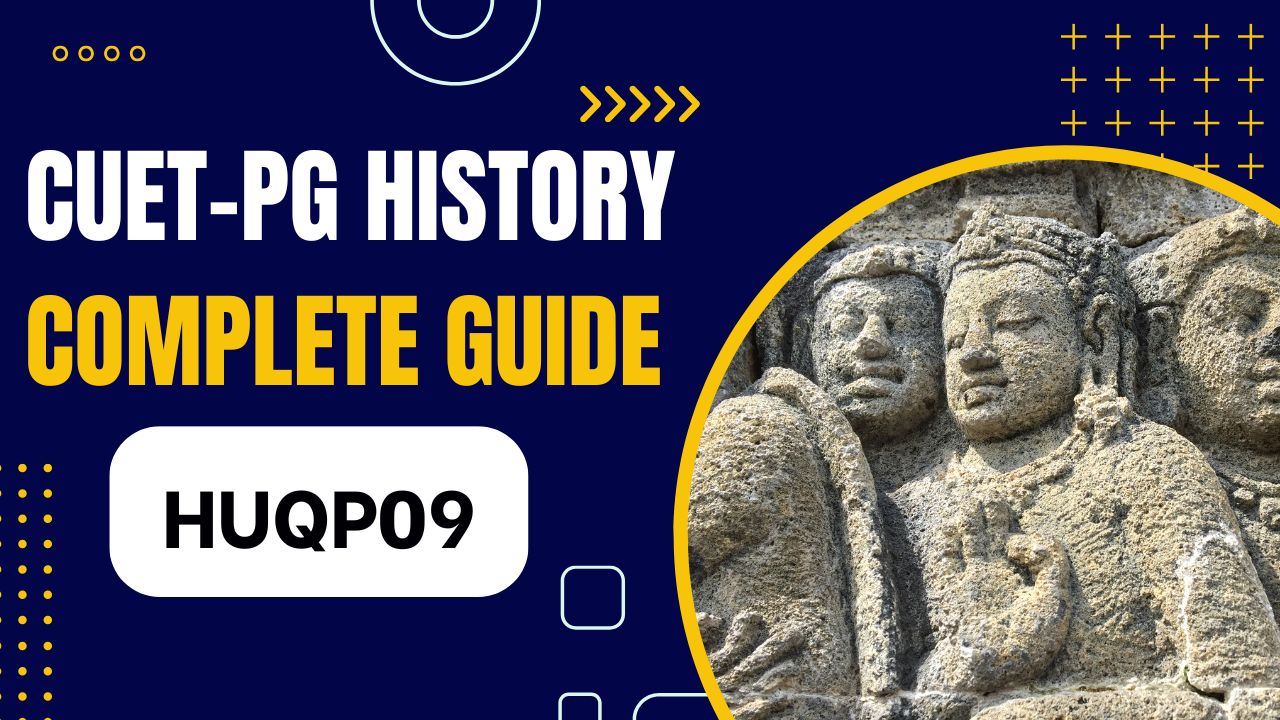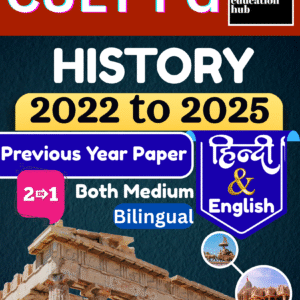
CUET-PG History [HUQP09] Exam 2026 Syllabus II Books II Particapted Universities II Seats in DU II Cut-off II Previous Year Paper II Exam Pattern & Career Scope II Eligibility Criteria & level of Exam
The CUET-PG History [HUQP09] examination is a national-level entrance test conducted by the National Testing Agency (NTA) for admission to postgraduate History programs across top central and participating universities in India. This exam is a gateway to prestigious institutions such as Delhi University (DU), Jawaharlal Nehru University (JNU), BHU, and others. This guide provides a detailed overview of the 2026 CUET-PG History exam, covering the syllabus, recommended books, participating universities, seat matrix, cut-off trends, previous year papers, exam pattern, eligibility, and career prospects.
Table of Contents
Here’s a concise Exam Overview Table for CUET-PG History Exam 2026:
| Feature | Details |
|---|---|
| Exam Name | CUET-PG Geography 2026 |
| Full Form | Common University Entrance Test – Postgraduate (Commerce) |
| Conducting Authority | National Testing Agency (NTA) |
| Exam Level | National Level |
| Mode of Exam | Computer-Based Test (CBT) |
| Medium of Exam | English & Hindi (in most cases) |
| Duration | 105 minutes (1 hour 45 minutes) |
| Total Questions | 75 Questions |
| Total Marks | 300 Marks |
| Question Type | Multiple Choice Questions (MCQs) |
| Marking Scheme | +4 for correct answer, -1 for incorrect answer |
| Eligibility | Bachelor’s Degree in Commerce or equivalent (minimum 50% marks typically) |
| Frequency of Exam | Once a year |
| Official Website | https://pgcuet.samarth.ac.in |
CUET -PG History [HUQP09] Latest Syllabus 2026 [Chapter /Section] –
| Section | Time Period | Topics Covered |
|---|---|---|
| 1. Ancient History of India | 10000 BC to 1206 AD | – Stone Age: Paleolithic, Mesolithic, Neolithic- Chalcolithic Age- Indus Valley Civilization- Aryan & Vedic Age- State Formation in Ancient India |
| – Rise of Ancient Empires: Haryanka, Shishunaga, Nanda Dynasties- Buddhism & Jainism: Age of Religion- Mauryan Age (social, political, cultural aspects) | ||
| – Post-Mauryan: Indo-Greeks, Sakas, Kushanas, Western Kshatrapas- Early South Indian States: Kharavela, Satavahanas, Tamil Sangam Age (Administration, Economy, Art) | ||
| – Guptas, Vakatakas, Vardhanas (administration, society, culture)- Regional States: Kadambas, Pallavas, Chalukyas of Badami- Growth of Vaishnavism & Shaivism | ||
| – Palas, Senas, Rashtrakutas, Paramaras (polity & administration) | ||
| 2. Early Medieval India | 750 AD – 1206 AD | – Rise of Rajputs in Northern India- Chola Dynasty: Administration, Village Economy, Society- Indian Feudalism |
| – Agrarian Economy and Urban Settlements- Trade and Commerce | ||
| 3. Medieval History of India | 1206 AD – 1707 AD | – Establishment of Delhi Sultanate: Mamluk, Khilji, Tughlaq dynasties- Administration: Military reforms, Iqta system |
| – Art & Architecture- Vijayanagara and Bahmani Kingdoms (Rise, Society, Economy, Administration)- Bhakti and Sufi Movements | ||
| – Persian Literature and Cultural Developments- Mughal Empire: Establishment, Expansion (Babar to Aurangzeb), Administration, Society, Literature | ||
| – Rise of Sur Dynasty- Decline of Mughal Empire | ||
| 4. Modern History of India | 1707 AD – 1947 AD | – Modern Historiography- Colonialism and British Expansion- Imperialism- Structure of British Administration (all Acts) |
| – Economic Impact: Revenue Settlements, Industrialization- Social & Religious Reform Movements: Raja Ram Mohan Roy, Dayanand Saraswati, Jyotiba Phule, etc. | ||
| – National Movement: INC Sessions, Mass Movements, Gandhian Era, Constitutional Developments, Struggle for Freedom | ||
| – European History: French, English, American, and Russian Revolutions- World War I and World War II |
CUET-PG History (HUQP09) – Summary of Questions Asked (2022–2025)
| Year | Ancient History | Early Medieval History | Medieval History | Modern History | Total Questions |
|---|---|---|---|---|---|
| 2022 | 18 | 6 | 21 | 30 | 75 |
| 2023 | 16 | 7 | 23 | 29 | 75 |
| 2024 | 17 | 5 | 20 | 33 | 75 |
| 2025 | 15 | 6 | 24 | 30 | 75 |
🎯 CUET-PG History (HUQP09) Exam Difficulty Analysis (2022–2025)
| Year | Difficulty Level | Remarks Based on Previous Year Paper Analysis |
|---|---|---|
| 2022 | ⭐ Easy to Moderate | First year of CUET-PG; many questions were direct from NCERTs and standard UG-level texts. |
| 2023 | ⭐⭐ Moderate | Increase in conceptual and analytical questions; less reliance on one-liner factual memory. |
| 2024 | ⭐⭐⭐ Moderate to Hard | Questions required comparative historical understanding, matching events with years, and deep reasoning. |
| 2025 | ⭐⭐⭐⭐ Hard | Based on mock reviews and answer key discussions: assertion-reason, chronology, and source-based questions increased. |
📝 Topic-wise Trends in Difficulty:
| Section | Trend (2022–2025) |
|---|---|
| Ancient History | Factual in 2022–23 → More conceptual in 2024–25 |
| Medieval History | Balanced mix of art, architecture, movements |
| Modern History | Increasing focus on reformers, acts, and revolutions |
| Early Medieval History | Often overlooked but in 2025, match-the-following and polity-based questions appeared |
| Chapter / Unit | Recommended Books / Sources |
|---|---|
| 1. Ancient History of India (10000 BC–1206 AD) | ✅ Ancient India by R.S. Sharma (Old NCERT)✅ India’s Ancient Past by R.S. Sharma (for deeper context)✅ IGNOU BA History – EHI-01, EHI-02✅ Tamil Nadu Class 11 History Book |
| 2. Early Medieval India (750–1206 AD) | ✅ Early Medieval India by Romila Thapar✅ A History of South India by K.A. Nilakanta Sastri✅ IGNOU Notes (EHI-03)✅ History of Medieval India by Satish Chandra (Part 1) |
| 3. Medieval History of India (1206–1707 AD) | ✅ Medieval India by Satish Chandra (Part 1 & 2)✅ IGNOU – EHI-04✅ Medieval India by Harishankar Jha (for objective summaries)✅ Vision IAS notes (for Bhakti, Sufi) |
| 4. Modern History of India (1707–1947 AD) | ✅ Modern India by Bipan Chandra✅ Spectrum’s Modern History (Rajiv Ahir) – great for MCQs✅ IGNOU – EHI-05, EHI-06✅ NCERT Class 12 – Themes in Indian History Part III |
| 5. European & World History (Revolutions + Wars) | ✅ History of Modern Europe by B.V. Rao or Jain & Mathur✅ Mastering Modern World History by Norman Lowe (Selective reading)✅ NCERT Class 9–10 World History sections |
| 6. Historiography & Historical Methods | ✅ What is History? by E.H. Carr✅ IGNOU – MHI-01 (for MA level but simplified concepts)✅ UGC-NET History materials for source-based, objectivity–subjectivity concepts |
| 7. Art, Architecture, Culture | ✅ Nitin Singhania’s Indian Art and Culture (Selective)✅ NCERT Class 11 Fine Arts✅ CCRT official website (for Bhakti/Sufi arts) |
| 8. Social & Religious Reformers | ✅ Bipan Chandra’s Modern India✅ Spectrum’s chapters on Reform Movements✅ IGNOU EHI-05 / EHI-06 |
| 9. Indian National Movement | ✅ India’s Struggle for Independence by Bipan Chandra✅ Spectrum (for concise revision)✅ IGNOU MHI-04 (optional) |
| 10. Acts, British Administration, Constitution | ✅ Indian Polity by Laxmikanth (for acts like 1858, 1909, 1919, 1935)✅ Bipan Chandra (for historical context) |
Recommended Books
-
CUET-PG History II Previous Year Solved Paper II 2022 to 2025 II Bilingual II English & Hindi Medium II With Detail Solution II As Per Exam Pattern
Original price was: ₹800.00.₹299.00Current price is: ₹299.00.
🎓 Central Universities Offering MA History & Eligibility (CUET-PG)
| University | Seats | Eligibility | Remarks |
|---|---|---|---|
| Central University of Karnataka (CUK) | 33 | Any graduate with ≥ 50% marks (45% for OBC–NCL/SC/ST/PwD) + CUET‑PG exam needed reddit.com+14collegedunia.com+14collegedunia.com+14 | Annual fees approx. ₹36,200; entrance via CUET‑PG. |
| Central University of South Bihar (CUSB) | 45 | Any discipline graduate with ≥ 50% marks (45% for SC/ST) + CUET‑PG | CUET cutoffs: general rank ~97–166; home-state ~150–176 . |
| Central University of Himachal Pradesh (CUHP) | 33 | Graduate with ≥ 50% marks (45% for PwD; OBC similar) + CUET‑PG | Total fees ~₹14.9 k; admission via CUET‑PG. |
| Central University of Tamil Nadu (CUTN) | 26 | Any graduate with ≥ 55% marks (50% OBC, 45% SC/ST/PwD) + CUET‑PG | CUET cutoffs: general rank ~40–227 . |
| Central University of Punjab (CUP) | — | Graduate with ≥ 55% marks (50% OBC/PwD) + CUET‑PG | Only percentage criteria mentioned; seats not specified. |
| Central University of Haryana (CUH) | 30–35 | Graduate with ≥ 50% marks (45% for SC/ST/OBC/PwD) + CUET‑PG | Combined MA in History & Archaeology; low tuition (~₹2,000 over 2 years). |
Seats in DU & JNU For PG History
Here are the seat details for MA History at both Delhi University (DU) and Jawaharlal Nehru University (JNU) based on the latest available data:
🎓 Delhi University – MA History [Approx]Seat matrix across DU’s main colleges and NCWEB:
| College / Department | UR | SC | ST | OBC | EWS | Total |
|---|---|---|---|---|---|---|
| History – Dept. North Campus | 27 | 8 | 5 | 18 | 5 | 63 |
| History – Dept. South Campus | 13 | 6 | 1 | 9 | 5 | 34 |
| Daulat Ram College (W) | 3 | 1 | 1 | 2 | 1 | 8 |
| Hansraj College | 3 | 1 | 1 | 2 | 1 | 8 |
| Hindu College | 3 | 2 | 0 | 2 | 1 | 8 |
| Indraprastha College (W) | 3 | 2 | 0 | 2 | 1 | 8 |
| Janki Devi Memorial College (W) | 2 | 1 | 0 | 1 | 1 | 5 |
| Kamala Nehru College (W) | 3 | 1 | 1 | 2 | 1 | 8 |
| Kirori Mal College | 3 | 1 | 1 | 2 | 0 | 7 |
| Lady Shri Ram College for Women (W) | 4 | 2 | 0 | 3 | 1 | 10 |
| Miranda House (W) | 3 | 2 | 1 | 2 | 1 | 9 |
| Rajdhani College | 2 | 1 | 0 | 2 | 0 | 5 |
| Ramjas College | 4 | 2 | 1 | 3 | 0 | 10 |
| SGTB Khalsa College | 1 | — | — | — | — | 1 |
| Sri Venkateswara College | 4 | 1 | 1 | 3 | 0 | 9 |
| St. Stephen’s College | 1 | — | 1 | — | — | 2 |
| Zakir Husain Delhi College | 2 | 0 | 0 | 1 | 1 | 4 |
| NCWEB (Open & Reserve) | 29 | 11 | 5 | 19 | 7 | 71 |
| 🧾 Total Seats Across DU (All Colleges) | 110 | 42 | 19 | 73 | 26 | 270 |
- The overall seat count is approximately 270 for MA History across DU’s North/South campus, affiliated colleges, and NCWEB.
- Admission is category-wise based on CUET-PG scores, with separate cut-offs for UR, SC/ST, OBC, and EWS categories.
JNU
JNU – MA History: Total 105 seats (approx. split into 31 Ancient, 25 Medieval, 43 Modern), fully via CUET‑PG merit.
SECOND ROUND OF ALLOCATION AND ADMISSIONS – MINIMUM ALLOCATION SCORE 2025 [Cut-off]
| Sr. No. | College | Cycle | Category | CUET Rank |
|---|---|---|---|---|
| 556 | Daulat Ram College | C2 | EWS | 126 |
| 557 | Daulat Ram College | C2 | SC | 98 |
| 558 | Daulat Ram College | C2 | OBC | 131 |
| 559 | Daulat Ram College | C2 | UR | 141 |
| 560 | Daulat Ram College | C1 | EWS | 150 |
| 561 | Daulat Ram College | C1 | ST | 107 |
| 562 | Daulat Ram College | C1 | SC | 139 |
| 563 | Daulat Ram College | C1 | OBC | 150 |
| 564 | Daulat Ram College | C1 | UR | 164 |
| College / Dept. | Cycle | Category | CUET Rank |
|---|---|---|---|
| Department of History | C2 | EWS | 132 |
| Department of History | C2 | ST | 66 |
| Department of History | C2 | SC | 115 |
| Department of History | C2 | OBC | 132 |
| Department of History | C2 | UR | 161 |
| Department of History | C1 | PWD | 109 |
| Department of History | C1 | EWS | 159 |
| Department of History | C1 | ST | 133 |
| Department of History | C1 | SC | 143 |
| Department of History | C1 | OBC | 161 |
| Department of History | C1 | UR | 187 |
🌟 Top Career Opportunities After M.A. History
| Career Path | Role & Description | Where to Apply / Work |
|---|---|---|
| 1. Teaching & Academia | Lecturer/Assistant Professor in colleges or universities (after UGC-NET/Ph.D.) | Colleges, Universities, Coaching Institutes |
| 2. Research Scholar | Conduct historical research; publish papers/books; assist in funded academic projects | ICHR, ICSSR, Museums, Think Tanks |
| 3. Civil Services | Prepare for UPSC / State PCS (History is a strong optional subject) | UPSC, State Public Service Commissions |
| 4. Archivist / Curator | Preserve, manage and organize historical documents, manuscripts, artifacts | National Archives, Museums, Archaeological Survey of India |
| 5. Historian / Author | Write books, biographies, historical analysis articles | Publishing houses, Journalism, Self-employed |
| 6. Museum Education Officer | Create educational content for visitors, conduct tours, historical storytelling | National/State Museums, Heritage Centres |
| 7. Archaeologist | Field excavation, artifact analysis, site preservation (usually with further training or diploma) | ASI, UNESCO projects, private archaeological firms |
| 8. Cultural Heritage Manager | Manage and conserve cultural assets, design heritage tours | INTACH, Ministry of Culture, Tourism Boards |
| 9. Content Developer / Editor | Create historical content for websites, e-learning platforms, books, or curriculum | EdTech Companies, Publishers, Competitive Exam Institutes |
| 10. Journalism & Media | Become a history-based columnist, researcher, or documentary scriptwriter | Print Media, TV Channels, History Networks |
| 11. NGO/Policy Analyst | Work in heritage preservation, education, human rights, or gender history research | NGOs, International Organisations (UNESCO, UNDP) |
| 12. International Relations | History background is valued in IR, diplomacy, and policy-making | MEA, Embassies, Think Tanks (ORF, IDSA) |
💼 Salary Structure After M.A. History (India)
| Job Role / Career Path | Starting Salary (Monthly) | Experienced Salary | Remarks |
|---|---|---|---|
| Assistant Professor (NET/PhD) | ₹45,000 – ₹75,000 | ₹1.2 – ₹1.5 Lakh+ | UGC Pay Scale (Level 10–12); requires NET or Ph.D. |
| School Teacher (TGT/PGT) | ₹35,000 – ₹60,000 | ₹60,000 – ₹80,000+ | In private schools or through CTET/State TET in public schools |
| Historian / Researcher | ₹30,000 – ₹50,000 | ₹70,000+ | In research institutes, government projects (ICHR, ICHR-JRF, ICSSR, etc.) |
| Archivist / Curator | ₹35,000 – ₹60,000 | ₹70,000 – ₹1 Lakh+ | National Archives, ASI, Museums, Govt. cultural bodies |
| Civil Services (IAS, etc.) | ₹56,100 (Basic Pay) | ₹1.2 Lakh – ₹2.5 Lakh | Includes DA, HRA, TA; history helps in optional subject |
| Archaeologist (ASI, Govt.) | ₹45,000 – ₹70,000 | ₹90,000 – ₹1.2 Lakh | ASI Group A/B services; requires specialization/diploma in archaeology |
| Content Developer / Editor | ₹25,000 – ₹40,000 | ₹50,000 – ₹80,000 | In EdTech, publishing, competitive exam content platforms |
| Museum Education Officer | ₹30,000 – ₹45,000 | ₹60,000 – ₹90,000 | Cultural outreach, documentation roles |
| Tour Guide / Heritage Expert | ₹20,000 – ₹35,000 | ₹40,000 – ₹70,000 (seasonal/commission-based) | Govt. certified guides or with private agencies |
| NGO / Policy Research Analyst | ₹30,000 – ₹50,000 | ₹60,000 – ₹1 Lakh | Working in areas like education, culture, heritage policy |
| Journalist / Script Writer | ₹25,000 – ₹40,000 | ₹60,000 – ₹1.2 Lakh+ | In documentary, historical fiction, research-based production |
📘 CUET-PG Exam Pattern (2026)
| Feature | Details |
|---|---|
| Exam Mode | Computer-Based Test (CBT) |
| Conducting Body | National Testing Agency (NTA) |
| Total Questions | 75 Questions |
| Type of Questions | Multiple Choice Questions (MCQs) |
| Total Marks | 300 Marks |
| Marking Scheme | ✅ +4 for each correct answer ❌ −1 for each incorrect answer |
| Time Duration | 1 hour 30 minutes (90 minutes) |
| Medium of Paper | English & Hindi (bilingual, except for language papers) |
| Sections | Only one section – Subject-specific (no general test or language test) |
| Subject Code for History | HUQP09 |
CUET PG 2025 Counselling Timeline
| Event | Tentative Dates |
|---|---|
| CUET PG Result Declaration | May 6, 2025 |
| Counselling Registration Start | June 2025 |
| Document Verification | June – July 2025 |
| Seat Allotment Rounds | July 2025 |
| Commencement of Classes | August 2025 |
Note: Specific dates may vary by university. Always check the official website of each institution for accurate timelines.
🧭 Step-by-Step Counselling Process
- Check Eligibility & Cut-offs: After results are declared, universities release their course-wise cut-off marks. Ensure you meet these criteria before applying.
- Register Online: Visit the official website of each university you’re interested in and complete the counselling registration. This typically involves:
- Filling in personal and academic details
- Uploading necessary documents
- Paying a registration fee (amount varies by university)
- Choice Filling: Select your preferred courses and campuses in order of priority. Ensure you review and lock your choices before the deadline.
- Document Verification: Universities will verify the authenticity of your submitted documents. This may be done online or in person, depending on the institution’s process.
- Seat Allotment: Based on your CUET PG score, category, and preferences, universities will allot seats. Results are typically published on the respective university’s portal.
- Acceptance & Fee Payment: If allotted a seat, confirm your acceptance by paying the admission fee within the stipulated time. Failure to do so may result in forfeiture of the seat.
- Subsequent Rounds & Spot Counselling: If seats remain vacant, universities may conduct additional rounds or spot counselling. Stay updated with each university’s announcements.
📄 Documents Required
Ensure you have both the original and photocopies of the following:
- CUET PG 2025 Scorecard
- CUET PG 2025 Admit Card
- Class 10th & 12th Mark Sheets and Certificates
- Bachelor’s Degree Mark Sheets and Certificate
- Transfer Certificate (TC)
- Migration Certificate (if applicable)
- Caste/Category Certificate (if applicable)
- Domicile Certificate (if required by the university)
- Income Certificate (for scholarship considerations)
- Passport-sized Photographs
- Valid ID Proof (Aadhar Card, Voter ID, or PAN Card)
CUET-PG History Previous Year Papers 2022 to 2025
| Year | Availability | Download Link |
|---|---|---|
| 2024 | ✅ Available | Download PDF |
| 2023 | ✅ Available | Download PDF |
| 2022 | ✅ Available | Download PDF |
| 2021 | ✅ Available | Download PDF |
📘 CUET-PG History (HUQP09) – FAQ Table
| S. No. | Question | Answer |
|---|---|---|
| 1 | What is the syllabus for CUET PG History? | Ancient to Modern Indian History, Early Medieval, European Revolutions, World Wars, and Historiography. |
| 2 | What is the exam pattern for CUET PG History? | 75 MCQs, 300 marks, 90 minutes, +4 for correct, −1 for wrong, bilingual (Hindi/English), subject code: HUQP09. |
| 3 | What is the difficulty level of CUET PG History paper? | 2022: Easy–Moderate; 2023: Moderate; 2024: Moderate–Hard; 2025: Expected Hard with assertion-reason and source-based questions. |
| 4 | Best books for CUET PG History preparation? | R.S. Sharma, Satish Chandra, Bipan Chandra, Norman Lowe (World History), IGNOU Notes (EHI Series), Spectrum for Modern India. |
| 5 | Career options after M.A. in History? | Assistant Professor, Researcher, Civil Services, Archaeologist, Archivist, Museum Curator, Content Developer, Tour Guide. |
| 6 | Which central universities offer M.A. History via CUET PG? | DU, JNU, Central Universities of Haryana, Karnataka, Punjab, South Bihar, Tamil Nadu, Himachal Pradesh, etc. |
| 7 | Expected cutoff rank for DU/JNU M.A. History? | DU: 140–187 (UR); JNU: 150–180 (UR) approx.; varies by category and college. |
| 8 | Can I prepare for CUET PG History in 3–4 months? | Yes, with structured planning, NCERTs + IGNOU, mock tests, and consistent MCQ practice. |
| 9 | Is there a General/Language paper in CUET PG History? | ❌ No. Only subject-specific questions (History only). |
| 10 | Is CUET PG score valid for Ph.D. or teaching? | ❌ No. CUET-PG is only for PG admissions. For Ph.D. or Assistant Professor, one must clear UGC-NET or separate university Ph.D. entrance. |


